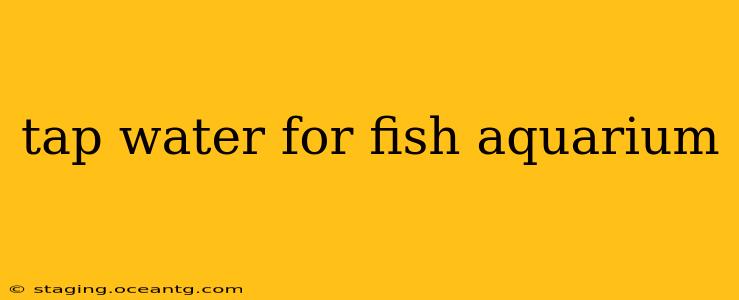Using tap water in a fish aquarium is a common practice, but it's crucial to understand the potential risks and how to mitigate them. While convenient, tap water often contains substances harmful to fish. This comprehensive guide will explore the intricacies of using tap water for your aquarium, addressing common concerns and offering solutions for safe and healthy aquatic environments.
Is Tap Water Safe for Fish Tanks?
The short answer is: it depends. Tap water's suitability depends heavily on its composition. Many municipal water supplies contain chlorine, chloramine, heavy metals, and other chemicals that can be toxic to fish. While some fish may tolerate low levels of these contaminants, prolonged exposure can lead to illness and death. Therefore, treating tap water before adding it to your aquarium is essential.
How to Treat Tap Water for Fish Tanks
Several methods effectively remove harmful substances from tap water, making it safe for your aquatic friends.
1. Dechlorination: Removing Chlorine and Chloramine
Chlorine and chloramine are added to municipal water to kill bacteria. However, these chemicals are highly toxic to fish. You can remove them using:
- Dechlorination drops: These readily available products neutralize chlorine and chloramine. Always follow the manufacturer's instructions carefully for accurate dosage.
- Activated carbon filtration: An activated carbon filter in your aquarium's filter system will gradually remove chlorine and chloramine from the water. However, this is a slower process and may not be sufficient for immediate water changes.
2. Water Conditioning: Addressing Other Impurities
Water conditioners are designed to address various other impurities present in tap water, such as heavy metals and minerals. These products typically contain:
- Chelating agents: These bind to heavy metals, preventing them from being absorbed by fish and plants.
- Mineral buffers: These help maintain the ideal pH and water hardness levels for your fish species.
Using a water conditioner alongside dechlorination is strongly recommended for a safe aquatic environment.
3. Water Testing: Monitoring Your Water Parameters
Regular water testing is crucial for maintaining a healthy aquarium. Regular tests will help you to monitor:
- pH: The acidity or alkalinity of the water.
- Ammonia: A toxic byproduct of fish waste.
- Nitrite: An intermediate product in the nitrogen cycle.
- Nitrate: The final, less toxic product in the nitrogen cycle.
- Hardness: The level of minerals in the water.
Testing kits are readily available and provide valuable insights into your water quality. This allows you to identify and address potential issues before they impact your fish.
What are the Risks of Using Untreated Tap Water?
Using untreated tap water exposes your fish to several risks:
- Toxicity: Chlorine and chloramine are highly toxic, leading to gill damage, respiratory distress, and death.
- Heavy metal poisoning: Heavy metals such as copper and lead can accumulate in fish tissues, causing various health problems.
- pH imbalances: Tap water's pH may not be suitable for your fish species, leading to stress and illness.
- Mineral imbalances: Excess minerals can harm fish or plants.
Can I Use Bottled Water for My Fish Tank?
While some bottled water is suitable, it's usually not cost-effective for regular aquarium use. Furthermore, some bottled waters contain minerals that may not be suitable for your fish, and lack the essential minerals that support plant growth. Always check the label to ensure the water is purified and free from additives.
How Often Should I Change the Water in My Aquarium?
The frequency of water changes depends on several factors, including tank size, fish species, and stocking levels. Generally, a 25% water change every one to two weeks is a good starting point. For smaller tanks or heavily stocked tanks, more frequent changes might be necessary.
What is the best way to condition tap water for a fish aquarium?
The best way involves a multi-step approach: First, use a dechlorinator to remove chlorine and chloramine. Second, use a water conditioner to address other impurities and help stabilize pH and hardness. Finally, test your water parameters to ensure they are within the optimal range for your fish species.
Conclusion
Using tap water in your aquarium is feasible, provided you take the necessary steps to treat it properly. Combining dechlorination, water conditioning, and regular water testing is essential for maintaining a healthy and thriving aquarium environment. Remember to choose products specifically formulated for aquarium use and always follow the manufacturer's instructions. Your fish will thank you for it!
